Each year around the end of October we feature plenty of Halloween-related projects, usually involving plastic skeletons and LED lights, or other fun tech for decorations to amuse kids. It’s a highly commercialised festival of pretend horrors which our society is content to wallow in, but beyond the plastic ghosts and skeletons there’s both a history and a subculture of the supernatural and the paranormal which has its own technological quirks. We’re strictly in the realm of the science here at Hackaday so we’re not going to take you ghost hunting, but there’s still an interesting journey to be made through it all.
Today: Fun For Kids. Back Then: Serious Business
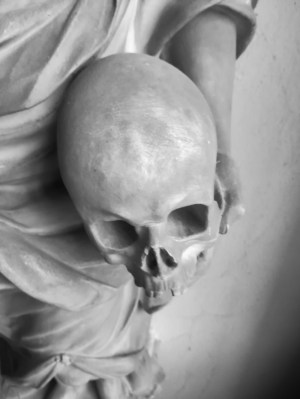
Halloween as we know it has its roots in All Hallows Eve, or the day before the remembrance festivals of All Saint’s Day and All Soul’s Day in European Christianity. Though it has adopted a Christian dressing, its many trappings are thought to have their origin in pagan traditions such as for those of us where this is being written, the Gaelic Samhain (pronounced something like “sow-ain”). The boundary between living and dead was thought to be particularly porous at this time of year, hence all the ghosts and other trappings of the season you’ll see today.
Growing up in a small English village as I did, is to be surrounded by the remnants of ancient belief. They survive from an earlier time hundreds of years ago when they were seen as very real indeed, as playground rhymes at the village school or hushed superstitions such as that it would be bad luck to walk around the churchyard in an anticlockwise manner.
As a small child they formed part of the thrills and mild terrors of discovering the world around me, but of course decades later when it was my job to mow the grass and trim the overhanging branches in the same churchyard it mattered little which direction I piloted the Billy Goat. I was definitely surrounded by the mortal remains of a millennium’s worth of my neighbours, but I never had any feeling that they were anything but at peace.
Some Unexplained Phenomena Are Just That
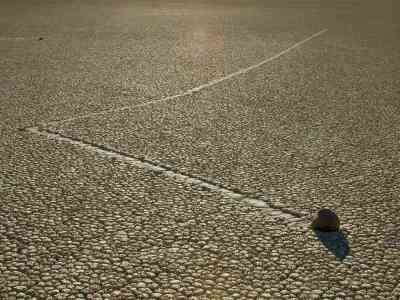
So as you might expect, nothing has persuaded me to believe in ghosts. I can and have walked through an ancient churchyard at night as I grew up next to it, and never had so much as a creepy feeling. I do however believe in unexplained phenomena, but before you throw a book at your computer I mean it in the exact terms given: observable phenomena we know occur, but can’t immediately explain.
To illustrate, a good example of a believable unexplained phenomenon was those moving rocks in an American desert; they moved but nobody could explain how they did it. It’s now thought to be due to the formation of ice underneath them in certain meteorological circumstances, so that’s one that’s no longer unexplained.
As another slightly less cut-and-dried example there are enough credible reports of marsh lights to believe that they could exist, but the best explanation we have, of spontaneous combustion of high concentrations of organic decomposition products, remains for now a theory. I hope one day a scientist researching fenland ecosystems captures one on their instruments by chance, and we can at last confirm or deny it.
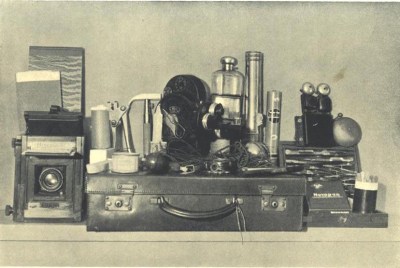
The trouble is with unexplained phenomena, that there are folks who would prefer to explain them in their own way because that’s what they want to believe. “I want to believe” is the slogan from the X Files TV show for exactly that reason.
People who want a marsh light or the sounds made by an old house as it settles under thermal contraction at night to be made by a ghost, are going to look for ghosts, and will clutch at anything which helps them “prove” their theories. In this they have naturally enlisted the help of technology, and thus there are all manner of gizmos taken into cemeteries or decaying mansions in the service of the paranormal. And of course in this we have the chance for some fun searching the web for electronic devices.
All The Fun Of Scam Devices
In researching this it’s been fascinating to see a progression of paranormal detection equipment over the decades, following the technological trends of the day. From early 20th century kits that resembled those used by detectives, to remote film cameras like the underwater Kodak Instamatic from a 1970s Nessie hunt we featured earlier this year, to modern multispectral imaging devices, with so much equipment thrown at the problem you’d expect at least one of them to have found something!
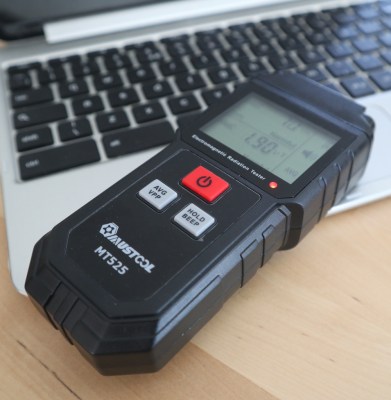
I’ve found that these instruments can be broadly divided into two camps: “normal” devices pressed into ghost-hunting service such as thermal cameras or audio recorders, and “special” instruments produced for the purpose. The results from either source may be digitally processed to “reveal” information, much in the manner of the famous “dead salmon paper“, which used an MRI of a dead fish to make a sarcastic comment about some research methodologies.
I’ve even discovered that I may have inadvertently reviewed one a few years ago, a super-cheap electric field meter touted as helping prevent some medical conditions, which I found to be mostly useful for detecting cables in my walls. Surprisingly I found it to be well engineered and in principle doing what it was supposed to for such an instrument, but completely uncalibrated and fitted with an alarm that denounced the mildest of fields as lethal. At least it was a lot cheaper than an e-meter.
Tomorrow night, there will be those who put on vampire costumes to be shepherded around their neighbourhoods in search of candy, and somewhere in the quiet country churchyard of an Oxfordshire village, something will stir. Is it a spectre, taking advantage of their yearly opportunity for a sojourn in the land of the living? No, it’s a solitary fox, hoping to find some prey under the moonlight in the undergrowth dividing the churchyard from a neighbouring field.
Wherever you are, may your Halloween be a quiet and only moderately scary one.
Header: Godstone, Surrey: Gravestone with skull and bones by Dr Neil Clifton, CC BY-SA 2.0.

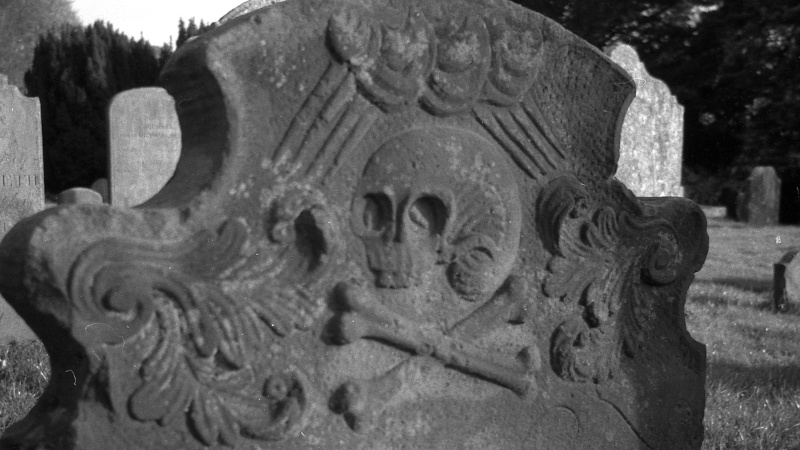














I find the persistent interest in ghost hunting as baffling as the persistence of “ufology.” Two sides of the same coin. Nothing to see but plenty money to be made off of the credulous.
I think that most of both are just for a bit of fun, while a minor but extremely vocal subset thinks it’s real. Kind of like buying scratch-off tickets at the gas station.
Wait a second! UFOS are real, probe me wrong.
prove me wrong :)
Freudian slip…
Cross-dressers.
Freudian slips and crossdressing…does who bring some topic first into a conversation are those who are more inclined/interested in…
Anyway going back to the original conversation, technically UFOS are real, same for USOS or any other acronym we use to designate those unidentified objects. I think the armies in each different country have some acronyms to designate them also. That said, a drone can actually be an UFO until someone identify it as a drone. So yeah they are real.
Freudian ship
Of course you can’t. :)
My gunny once said that, “statistically, half of all people are below average. No amount of education or training will make most most idiots useful for anything other than F*g over”.
2600 years ago, Theognis wrote “…by teaching never will you make the bad man good.”
So it’s a fairly ancient sentiment.
A for the time unexplained phenomenon that witnessed (we were for and all saw it… quite close)
We were all for sitting and standing in the wooden stairway ground floor to first floor, weather was very hot (for the time) and heavy – June – and dry. Not a single drop of rain but we could hear the thunder. Then a lightning (bight yellow glow, about twice the diameter of a tennis ball entered the house from the open window mid-floor, bounced a couple of time downwards, passing max one foot from my, and accelerated, bursting violently into nothing with very dry sound on the heater body (central heating) in the corridor front of the staircase. Microwave, TV, a couple of radios, all electric appliances instantaneously killed. Not sure they was thunder immediately before or after, but we all remember clearly to this day this very dry sound.
Back forwards, it has been scientifically observed, but still remains largely mysterious. It fully corroborate this observation: https://arstechnica.com/science/2014/01/the-dirty-secret-behind-ball-lightning-is-dirt/ :
Because everything was so dry that day, it´s very likely that by hitting the ground a plasma ball bounced high enough to enter the window. Classic house for the region: tiles, stone, wooden windows, nothing as “attractive” as a grounded central heating water network.
But it had a weight since in bounced slightly on the wooden stairs before accelerating very fast in a almost straight line to the heating body.
Not many people believe in that story and I’m fine with it! I also never met anybody else than our group who experienced this. Call me a fool, maybe you will see it too.
A local lawyer runs seances as a hobby. I was almost hired by him to put together a seance room with high-tech special effects that could conceivably fool an expert.
For example, a reverse sound trranscriptor can make moaning appear to come from anywhere in the room – including moving from one side to the other. An audio spotlight can make different people hear different noises.
Both of these are fairly unknown to the general public, and would fool a great many people.
And so on.
He runs seances as a “hobby” or as a “side racket”?!
Because that doesn’t sound like he wants amusing fun-house tricks, that sounds like needs a mechanic to help shear the sheep.
If he accepts “donations” for his stances, that used to be considered criminal fraud – not sure what the modern legal interpretation is, but that’s pretty low even for a lawyer (and yeah, I’m one of them)
Marsh light combustion has been solved some time ago:
https://www.pnas.org/doi/full/10.1073/pnas.2521255122
Now that is cool.
“We use cookies on this site to enhance your user experience. By using this website, you are giving your consent for us to set cookies. Find out more”
Yeah cute but that is not how things work in the EU.
And probably not even in the US anymore.
Idea for a costume:
Put an orange pumpkin on your head, then wear a blue suit with a white shirt and a red tie and threat everybody with tarrifs.
+1
Even better, use a brown gourd and threaten everyone with the “fundamental transformation” of their country.
I got asked to make an ‘orgone accumulator’ once for a friend that wanted to do some research, I did try to convince them it was all tosh but they still wanted one built.
I never did build it for them but it would’ve been interesting to study them while they studied the effects of it, as I find it interesting how people will bend themselves into all sorts of pretzels to justify their position.
Human behaviour is propelled by motivations / beliefs. Even with wrong but strong motivation people can produce impressive outcomes. Ufos, gods and souls of deads are interesting and strong motivations and the half-empty area of our knowledge there is only reinforcing the matter that we cannot rule out such explainations of strange phenomenons.
Excellent point about the progression of “paranormal detection equipment” tracking right along with general technological trends! It makes perfect sense that as cameras became common, people hunted Nessie with them, and now with ubiquitous digital sensors, we see EMF meters and thermal cameras pressed into ghost-hunting service.